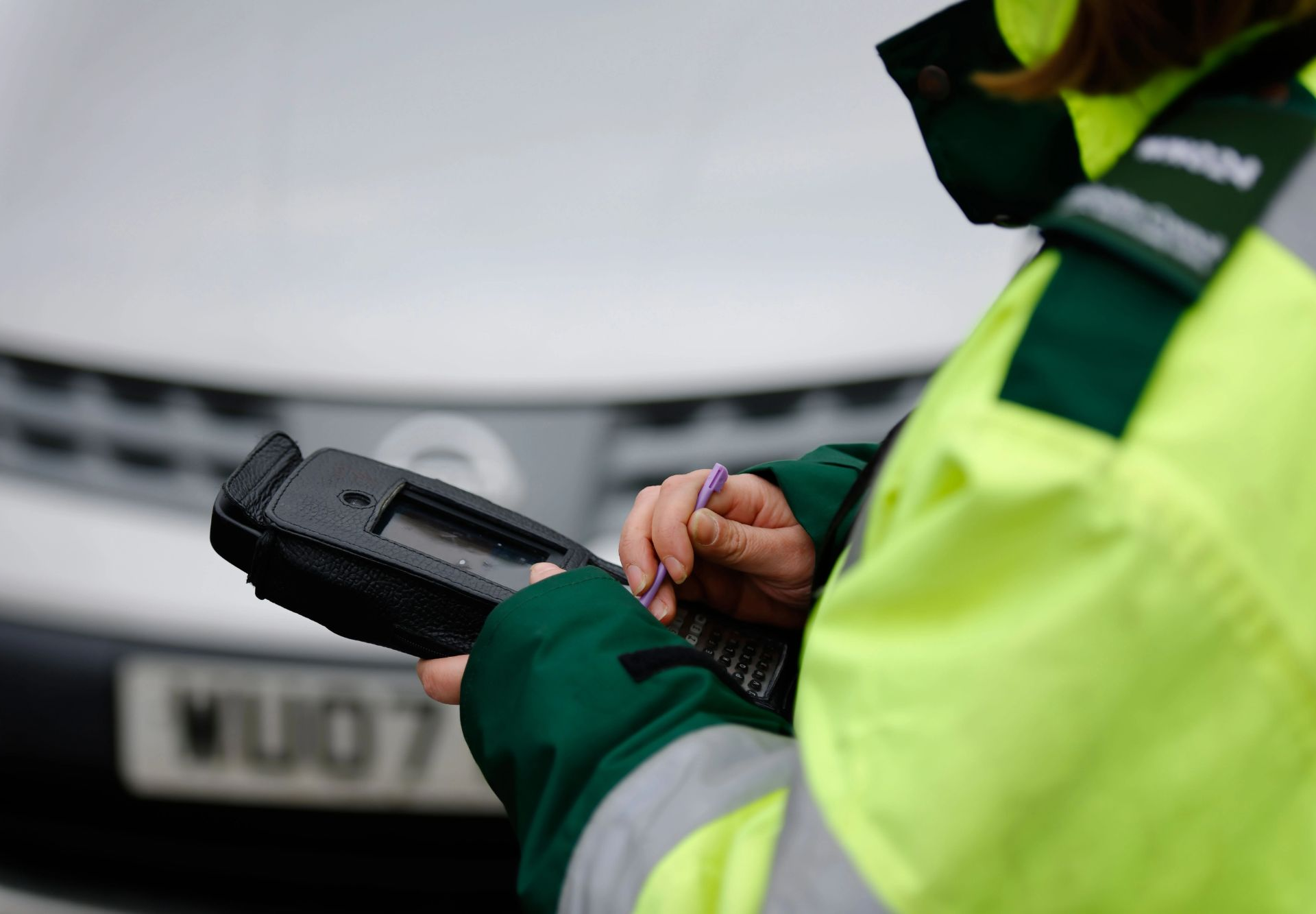Traffic wardens, also known as parking enforcement officers, use various methods and tools to determine how long a vehicle has been parked in a particular location. Here are some common techniques they might use:
- Chalking tires and checking alignment.
- Handheld devices that scan license plates.
- Checking parking meters and payment systems.
- Reviewing surveillance camera footage.
- Regular patrols and manual observation.
- Checking parking permits for expiration.
What Are The Methods Utilized by Traffic Wardens?
Efficient traffic management hinges on the diligent efforts of traffic wardens, who employ a range of strategic methods to ensure the smooth flow and safety of vehicles and pedestrians.
Checking Time of Arrival and Departure:
Traffic wardens often rely on visual observations to estimate the time of a vehicle’s arrival and departure. Moreover, they may note factors such as the presence of parking tickets or time-stamped receipts on the dashboard.
By comparing the current time with the time noted during the observation, wardens can calculate how long a vehicle has been parked.
Noting Parking Signage and Restrictions:
Visual cues in the form of parking signs play a crucial role in parking duration determination. Traffic wardens are trained to interpret parking signs that indicate time limits or specific parking regulations.
By cross-referencing the observed parking behavior with the relevant parking rules, they can determine whether a vehicle has exceeded the allowed parking duration.
Parking Meters and Pay-and-Display Systems

Explanation of Parking Meters and Their Operation:
Parking meters are physical devices located near parking spaces that allow users to pay for a specific amount of parking time. Moreover, users insert coins, tokens, or use digital payment methods to activate the meter, which then displays the amount of time purchased.
In addition, traffic wardens can check the meter to determine if the parking time has expired based on the displayed time or any expiration indicators.
Role of Pay-and-Display Machines in Indicating Parking Duration:
Pay-and-display machines provide a ticket or receipt after payment, which the vehicle owner displays on the dashboard.
Moreover, the ticket typically indicates the expiration time of the purchased parking duration. Traffic wardens can visually check the ticket to ensure that the displayed time has not lapsed.
Digital Solutions
Use of Electronic Parking Systems:
Modern parking management systems often utilize electronic solutions to monitor parking duration.
Additionally, these systems can include sensors embedded in the road or parking space that communicate wirelessly with a central server. When a vehicle enters or leaves a parking space, the sensor detects the change and updates the parking duration data.
Mobile Apps and Digital Platforms for Parking Monitoring:
Many cities offer mobile apps or digital platforms that allow users to pay for parking and receive digital receipts.
Moreover, traffic wardens can access real-time data from these systems to verify whether a vehicle’s parking time has expired. This digital approach provides more accurate and up-to-date information compared to traditional methods.
What Type Of Technological Tools Are Used for Monitoring Parking Duration?
In the realm of parking management, a variety of cutting-edge technological tools have emerged to closely monitor and regulate parking durations
Security Cameras and Surveillance Systems
Installation of Cameras in Parking Zones:
Surveillance cameras are strategically placed in parking zones to capture vehicle entry and exit times. Moreover, these cameras often have timestamps on their footage, allowing traffic wardens to review the recordings to ascertain the duration of parking.
Reviewing Footage to Track Entry and Exit Times:
Traffic wardens can review surveillance footage to determine when a vehicle entered and left a parking space. In addition, this method provides concrete evidence of parking duration, making it an effective tool for enforcement.
License Plate Recognition (LPR) Technology
How LPR Works to Identify Vehicles:
License Plate Recognition technology uses optical character recognition to read and convert license plate numbers into digital data. Additionally, LPR cameras capture images of vehicles’ license plates as they enter or exit parking areas.
Linking License Plate Data to Parking Duration:
By recording the license plate data along with the entry and exit times, traffic wardens can track how long a specific vehicle has been parked. Furthermore, this method is efficient and accurate, as it eliminates the need for manual data entry.
IoT Sensors and Smart Parking
Introduction to IoT Sensors:
Internet of Things (IoT) sensors are devices that collect and transmit data via the internet. In the context of parking, IoT sensors can be embedded in parking spaces to detect the presence of vehicles and wirelessly transmit this data to a central server.
Real-time Data Collection for Parking Duration Determination:
IoT sensors provide real-time data about parking space occupancy. When a vehicle enters or leaves a parking space, the sensor sends an immediate update to the server. However, traffic wardens can access this data to accurately determine how long a vehicle has been parked.
How Can You Data Manage and Process For Traffic Warden?

It’s crucial for traffic wardens to understand how to interpret the data collected from various sources, such as sensors, cameras, and electronic systems.
Traffic Warden Training
Educating Wardens on Interpreting Parking Data:
Proper training ensures that wardens can accurately assess parking duration and violations, reducing errors and wrongful enforcement.
Ensuring Accuracy and Fair Enforcement:
Training should emphasize the importance of treating all drivers fairly and consistently. Moreover, wardens need to be aware of potential biases and how to avoid them while interpreting data. Additionally, ensuring that wardens are well-informed and sensitive to different scenarios contributes to a just parking enforcement system.
Centralized Parking Databases
Storage of Parking Duration Information:
Centralized databases store the collected parking duration data, allowing for easy retrieval and analysis.
Moreover, this repository accumulates data from various sources, enabling a comprehensive view of parking activities over time. The database may store details like vehicle information, entry/exit times, and payment records.
Integration with Enforcement Systems:
Integrating the centralized database with enforcement systems, such as ticketing and violation tracking, streamlines the enforcement process.
In addition, when wardens encounter potential violations, they can quickly cross-reference data to confirm the violation before taking action. This integration reduces the chances of incorrect enforcement.
Automated Algorithms and Data Analysis
Using Algorithms to Identify Parking Violations:
Automated algorithms analyze parking data to identify potential violations, such as vehicles exceeding permitted parking durations or parking in restricted zones.
Moreover, these algorithms compare observed data with predefined rules and trigger alerts for wardens to investigate further. This approach enhances efficiency and accuracy in enforcement.
Minimizing Human Error through Automated Analysis:
Automation reduces the likelihood of human errors that might arise from manual data interpretation. By relying on algorithms and automated analysis, enforcement becomes more consistent and less susceptible to individual biases or mistakes. Hence, this enhances the overall reliability of the parking enforcement process.
How Does Parking Enforcement Know How Long You’ve Been Parked?
Parking officers check how long a car has been parked using different methods:
- Parking Meters: They look at the meter to see how much time has been paid for.
- Permits/Passes: They check if the car has a permit and see if it’s expired.
- Chalking Tires: Sometimes, they draw a mark on the tire and come back later to see if it’s still there.
- License Plate Cameras: Cameras take pictures of license plates to track when cars enter and leave parking spots.
- Parking Apps: Some cities use apps to pay for parking digitally. The app keeps track of how long a car has been parked.
- Patrols: Officers walk around to see if any cars have been parked for too long.
- Complaints: People can tell officers if a car has been parked in one spot for too long.
That’s how parking officers know if a car has been parked for too long!
What Are Legal and Ethical Considerations?
In the realm of data management and processing for traffic wardens, navigating the intricate landscape of legal and ethical considerations becomes paramount,
Privacy Concerns
Balancing Parking Enforcement with Individual Privacy:
As parking data is collected and stored, concerns about individual privacy arise. Striking a balance between effective enforcement and privacy rights is crucial.
Moreover, implementing measures to ensure that collected data is used solely for enforcement purposes and is not accessed or shared for unrelated reasons is essential.
Anonymizing Data to Protect Vehicle Owners:
To address privacy concerns, data can be anonymized before storage or analysis. This involves removing personally identifiable information, such as license plate numbers, from the dataset. Additionally, this way, while enforcement can still take place, the identity of the vehicle owners remains protected.
Transparency and Accountability
Providing Clear Information about Parking Rules:
Transparency is vital to building trust in the parking enforcement process. Clear and easily accessible information about parking regulations, time limits, and penalty structures helps drivers understand the rules they need to follow. This reduces confusion and frustration and encourages compliance.
Addressing Complaints and Disputes Related to Enforcement:
Establishing a mechanism to handle complaints and disputes is essential. When drivers believe they have been unfairly ticketed or penalized, they should have a way to appeal and present their case. A transparent process for reviewing enforcement decisions contributes to accountability and fairness.
FAQ’s :
What is the 5 Minute Rule for Parking Tickets?
The 5-minute rule in parking generally refers to a grace period given by some parking enforcement authorities.
However, if a vehicle is parked for a very short duration, typically around 5 minutes, it might not be subject to a parking ticket. This is often to account for quick drop-offs or pick-ups.
What Does “1 Hour No Return within 1 Hour” Mean?
The phrase “1 hour no return within 1 hour” usually indicates that after parking in a specific spot for an hour, you are not allowed to park there again within the following hour.
Moreover,This rule aims to prevent drivers from repeatedly using the same parking space in a short time frame and promotes turnover in high-demand parking areas.
How Do Parking Inspectors Know How Long Melbourne Is?
Parking inspectors typically use various methods to monitor parking durations. This can include digital parking meters, parking payment apps, and physical markings on tires.
Additionally, they don’t gauge the length of Melbourne itself; rather, they monitor how long a vehicle has been parked at a specific location.
Do You Have to Pay for Parking If You Are Sitting in the UK?
Yes, in most cases, you need to pay for parking in the UK even if you’re sitting in your vehicle. Additionally, payment is often required based on the duration of your stay. Regulations vary by location, so it’s important to check local parking rules and signage.
What Is the Best Excuse to Appeal a Parking Ticket?
The effectiveness of excuses varies, but valid reasons to appeal a parking ticket might include proof of a broken meter, unclear signage, or a legitimate emergency.
However, the strength of your argument depends on the specific circumstances and the discretion of the enforcement authority.
What Is the “Parking Eye” for 10 Minutes?
“Parking Eye” is a company that provides automatic number plate recognition (ANPR) technology for parking enforcement. The reference to “10 minutes” might relate to a specific parking time limit enforced by their system. This means that a vehicle might be allowed a 10-minute grace period before a violation is recorded.
Conclusion
In this discussion, we explored the intricate aspects of parking enforcement, including methods used to determine parking duration. Moreover, explore technological tools for monitoring, data management, legal and ethical considerations, and challenges faced by parking authorities.
Accurate parking enforcement contributes to efficient traffic flow, reduced congestion, and fair utilization of parking spaces. In addition, effective monitoring ensures a level playing field for all drivers and promotes compliance with parking regulations.











